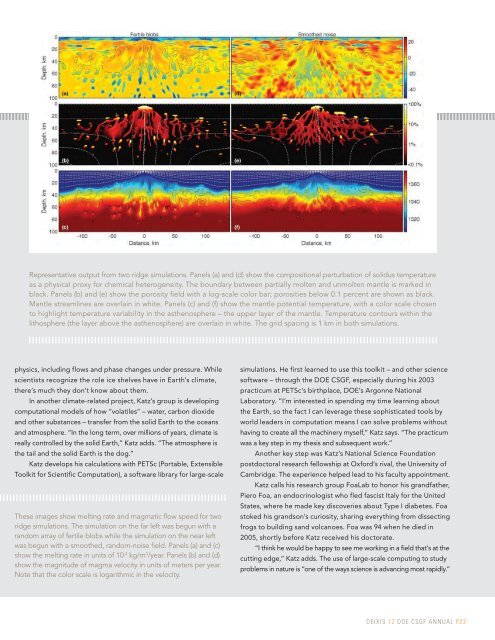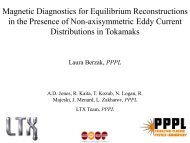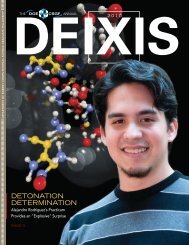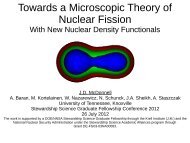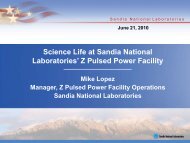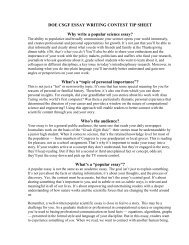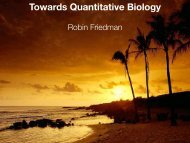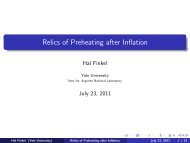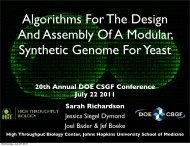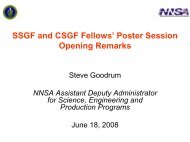2012 - Krell Institute
2012 - Krell Institute
2012 - Krell Institute
Create successful ePaper yourself
Turn your PDF publications into a flip-book with our unique Google optimized e-Paper software.
Representative output from two ridge simulations. Panels (a) and (d) show the compositional perturbation of solidus temperature<br />
as a physical proxy for chemical heterogeneity. The boundary between partially molten and unmolten mantle is marked in<br />
black. Panels (b) and (e) show the porosity field with a log-scale color bar; porosities below 0.1 percent are shown as black.<br />
Mantle streamlines are overlain in white. Panels (c) and (f) show the mantle potential temperature, with a color scale chosen<br />
to highlight temperature variability in the asthenosphere – the upper layer of the mantle. Temperature contours within the<br />
lithosphere (the layer above the asthenosphere) are overlain in white. The grid spacing is 1 km in both simulations.<br />
physics, including flows and phase changes under pressure. While<br />
scientists recognize the role ice shelves have in Earth’s climate,<br />
there’s much they don’t know about them.<br />
In another climate-related project, Katz’s group is developing<br />
computational models of how “volatiles” – water, carbon dioxide<br />
and other substances – transfer from the solid Earth to the oceans<br />
and atmosphere. “In the long term, over millions of years, climate is<br />
really controlled by the solid Earth,” Katz adds. “The atmosphere is<br />
the tail and the solid Earth is the dog.”<br />
Katz develops his calculations with PETSc (Portable, Extensible<br />
Toolkit for Scientific Computation), a software library for large-scale<br />
These images show melting rate and magmatic flow speed for two<br />
ridge simulations. The simulation on the far left was begun with a<br />
random array of fertile blobs while the simulation on the near left<br />
was begun with a smoothed, random-noise field. Panels (a) and (c)<br />
show the melting rate in units of 10 -3 kg/m 3 /year. Panels (b) and (d)<br />
show the magnitude of magma velocity in units of meters per year.<br />
Note that the color scale is logarithmic in the velocity.<br />
simulations. He first learned to use this toolkit – and other science<br />
software – through the DOE CSGF, especially during his 2003<br />
practicum at PETSc’s birthplace, DOE’s Argonne National<br />
Laboratory. “I’m interested in spending my time learning about<br />
the Earth, so the fact I can leverage these sophisticated tools by<br />
world leaders in computation means I can solve problems without<br />
having to create all the machinery myself,” Katz says. “The practicum<br />
was a key step in my thesis and subsequent work.”<br />
Another key step was Katz’s National Science Foundation<br />
postdoctoral research fellowship at Oxford’s rival, the University of<br />
Cambridge. The experience helped lead to his faculty appointment.<br />
Katz calls his research group FoaLab to honor his grandfather,<br />
Piero Foa, an endocrinologist who fled fascist Italy for the United<br />
States, where he made key discoveries about Type I diabetes. Foa<br />
stoked his grandson’s curiosity, sharing everything from dissecting<br />
frogs to building sand volcanoes. Foa was 94 when he died in<br />
2005, shortly before Katz received his doctorate.<br />
“I think he would be happy to see me working in a field that’s at the<br />
cutting edge,” Katz adds. The use of large-scale computing to study<br />
problems in nature is “one of the ways science is advancing most rapidly.”<br />
DEIXIS 12 DOE CSGF ANNUAL P23


